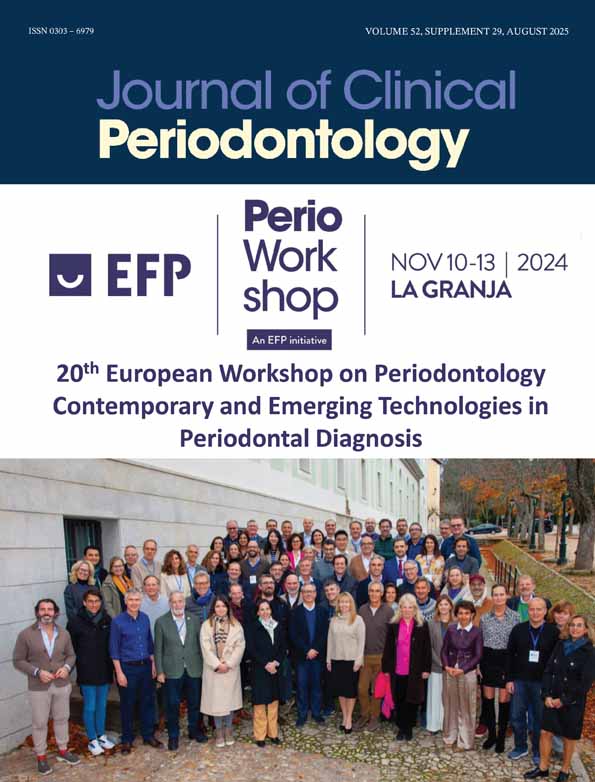Treatment of gingivitis with hyaluronan
Abstract
enObjectives: Hyaluronic acid (hyaluronan) is a glycosaminoglycan with anti-inflammatory and antiedematous properties. It was evaluated in a gel formulation for its effect in the treatment of plaque-induced gingivitis.
Method: In a randomised double-blind study, 50 male subjects with plaque-induced gingivitis were divided into two groups and used a verum or placebo gel twice daily additionally to oral hygiene for a 3-week treatment period. Clinical indices (API, Turesky index, PBI) and crevicular fluid variables (peroxidase, lysozyme) were determined at baseline and after 4, 7, 14 and 21 days, respectively.
Results: Significant improvements could be found for all clinical variables in both groups. The verum group showed significant improvement in the study area for the plaque indices beginning with day 4 (P = 0.011) and the PBI beginning with day 7 (P = 0.001) in comparison with the placebo group. The crevicular fluid variables were significantly improved in the centre of the studied inflammation area in the verum group. Here all studied sites had significant decreases in peroxidase (176.72–128.75 and 188.74–128.75 U/L) and lysozyme (1.27–0.27 and 1.30–0.33 mg/L) activities after 7, 14 and 21 days (P between 0.034 and < 0.001), whereas in the placebo group only one site showed a significant decrease for lysozyme (1.74–0.75 mg/L) after 7 and 21 days (P = 0.048 and 0.025).
Conclusions: These data suggest that a hyaluronan containing gel has a beneficial effect in the treatment of plaque-induced gingivitis.
Zusammenfassung
deBehandlung der Gingivitis mit Hyaluronan
Ziele: Hyaluronsäure (Hyaluronan) ist ein Glycosaminoglycan mit entzündungshemmenden und ödemhemmenden Eigenschaften. Sein Effekt in der Behandlung der plaque-induzierten Gingivitis wurde in einer Gelapplikation überprüft.
Methoden: In einer randomisierten doppelten Blindstudie wurden 50 Männer mit einer plaque-induzierten Gingivitis in zwei Gruppen aufgeteilt. Sie nutzten zusätzlich zur oralen Hygiene während einer dreiwöchigen Behandlungsperiode entweder das Wirkstoffgel oder ein Placebogel zweimal täglich. Die klinischen Indices (API, Turesky Index, PBI) und Variable der creviculären Flüssigkeit (Peroxidase, Lysozym) wurden zur Basis und nach 5, 7, 14 und 21 Tagen bestimmt.
Ergebnisse: Signifikante Verbesserungen für alle klinischen Variablen in beiden Gruppen konnten gefunden werden. Die Wirkstoffgruppe zeigte eine signifikante Verbesserung im Studiengebiet für die Plaqueindices beginnend am Tag 4 (p=0,011) und den PBI beginnend mit Tag 7 (p=0,001) verglichen mit der Placebogruppe. Die Variablen der creviculären Flüssigkeit wurden in der Wirkstoffgruppe im Zentrum des untersuchten Entzündungsgebietes signifikant verbessert. Alle untersuchten Flächen hatten einen signifikanten Abfall in der Peroxidase- (176,72 zu 128,75 und 188,74 zu 128,75 U/l) und Lysozymaktivität (1,27 zu 0,27 und 1,30 zu 0,33 mg/l) nach 7, 14 und 21 Tagen (p zwischen 0,034 und <0,001), während in der Placebogruppe nur eine Fläche einen signifikanten Abfall für Lysozym (1,74 zu 0,75 mg/l) nach 7 und 21 Tagen zeigte (p=0,048 und 0,025).
Schlussfolgerungen: Die Daten deuten darauf hin, dass ein Hyaluronan enthaltendes Gel einen verbessernden Effekt in der Behandlung der durch Plaque induzierten Gingivitis hat.
Résumé
frTraitement de la gingivite par l’acide hyaluronique
Objectifs: L’acide hyaluronique (hyaluronan) est un glycosaminoglycane possèdant des propriétés anti-inflammatoires et anti-oedemateuses. Il a étéévalué dans une formule en gel pour ses effets dans le traitement de la gingivite due à la plaque.
Methode: Lors d’une étude randomisée en double aveugle, 50 sujets masculins présentant une gingivite due à la plaque furent divise en 2 groupes et utilisèrent un gel verum ou placebo deux fois par jour en complément de l’hygiène buccale pendant 3 semaines. Les indices cliniques (API, indice de Turesky, PBI) et des variables du fluide gingival (peroxidase, lysozyme) furent déterminé au départ et après 4, 7, 14, et 21 jours respectivement.
Résultats: Des améliorations significatives purent être montrées pour toutes les variables cliniques dans les deux groupes. Le groupe verum présentait une amélioration significative dans le cadre de l’étude pour les indices de plaque des le quatrième jour (p=0.011) et pour le PBI des le septième jour (p=0.001) par rapport au groupe placebo.
Les variables du fluide gingival étaient significativement améliorées au centre de la surface enflammée étudiée dans le groupe verum. Ici, sur tous les sites étudiés, il y avait une diminution de l’activité de la peroxidase (176.72 à 128.75 et 188.74 à 128.75 U/l) et du lysozyme (1.27 à 0.27 et 1.30 à 0.33 mg/l) après 7, 14, et 21 jours (p entre 0.034 et < 0.001), alors que dans le groupe placebo, seul un site présentait une diminution significative du lysosyme (1.74 à 0.75 mg/l) après 7 et 21 jours (p = 0.48 et 0.025).
Conclusions: Ces données suggèrent qu’un gel contenant de l’acide hyaluronique a un effet bénéfique dans le traitement de la gingivite due à la plaque.




